Did you know that Eritrea, located in the northeastern corner of the Horn of Africa, is home to 126 mammal species, 557 bird species, 90 reptiles, 19 amphibians, and 700 plants? With its diverse habitats and ecosystems, including Juniperus forests, riverine forests, and coral reefs, Eritrea boasts an impressive array of biodiversity.
However, years of armed struggle, persistent drought, and environmental neglect have taken a toll on the country’s natural resources, leading to significant environmental degradation and loss of biodiversity. Recognizing the importance of conservation, Eritrea has been working diligently to protect its sacred natural sites and preserve its unique ecosystems.
Key Takeaways
- Eritrea is rich in biodiversity, with diverse habitats and ecosystems.
- Years of armed struggle, drought, and environmental neglect have caused environmental degradation and loss of biodiversity in Eritrea.
- Sacred natural sites in Eritrea hold cultural and spiritual significance and play a vital role in preserving the country’s cultural heritage.
- Eritrea has implemented a National Biodiversity Strategy and Action Plan to protect and conserve its biodiversity.
- Threats to Eritrea’s biodiversity include unregulated expansion of land, overgrazing, illegal hunting, and climate change.
Biodiversity Status and Trends in Eritrea
Eritrea is home to a diverse array of ecosystems, making it a hot spot for biodiversity. However, the country’s biodiversity is currently facing significant threats and challenges. Anthropogenic activities, such as the expansion of agricultural land and the excessive collection of firewood, have led to the depletion of natural resources and the degradation of terrestrial habitats. This has had a detrimental impact on the wildlife populations in these areas, including endangered and endemic species.
Illegal hunting of wildlife further worsens the situation, posing a serious threat to the delicate balance of ecosystems in Eritrea. In addition, the rapid coastal development, fishing activities, and tourism have resulted in the degradation and destruction of marine habitats, particularly coral reefs and seagrass beds. Climate change further exacerbates these challenges, affecting the fragile ecosystems and the species that depend on them for survival.
Eritrea is committed to preserving its unique biodiversity and has implemented the National Biodiversity Strategy and Action Plan (NBSAP) to monitor and protect its endangered species and habitats. The NBSAP focuses on the conservation of wildlife sanctuaries and the preservation of indigenous knowledge related to biodiversity. Efforts are being made to raise awareness about the importance of biodiversity and the need for sustainable practices among local communities and stakeholders. These initiatives aim to ensure the long-term sustainability and resilience of Eritrea’s biodiversity.
“Biodiversity is the foundation of a healthy and thriving environment. It is crucial that we take decisive actions to protect and conserve the rich biodiversity in Eritrea. By doing so, we not only safeguard our natural heritage but also contribute to sustainable development and the well-being of future generations.”
Eritrea’s Wildlife Sanctuaries
Eritrea is home to several wildlife sanctuaries that serve as important hubs for biodiversity conservation. These protected areas provide a safe haven for a wide range of plant and animal species, offering them the necessary habitats and resources for survival. Some of the notable wildlife sanctuaries in Eritrea include:
| Wildlife Sanctuary |
Main Species |
| Dankalia Wildlife Sanctuary |
Gazelles, antelopes, ostriches |
| Debub-Highland Sustainable Land Use System |
Juniperus forests, endemic bird species |
| Gahalb Coastal Wildlife Sanctuary |
Turtles, migratory birds, marine species |
These wildlife sanctuaries play a crucial role in conserving endangered species and protecting the delicate ecosystems in Eritrea. They provide opportunities for research, eco-tourism, and education, offering visitors a unique glimpse into the country’s rich biodiversity.
https://www.youtube.com/watch?v=OBf6gEeUWOA
Eritrea’s Sacred Natural Sites
Eritrea has a strong cultural and spiritual connection to its natural environment, with many sacred natural sites spread across the country. These sites hold great significance for local communities and play a vital role in preserving the country’s cultural heritage. These sacred sites are often associated with traditional rituals and ceremonies that honor and respect nature. Efforts are being made to protect and conserve these sacred natural sites to ensure their preservation for future generations.
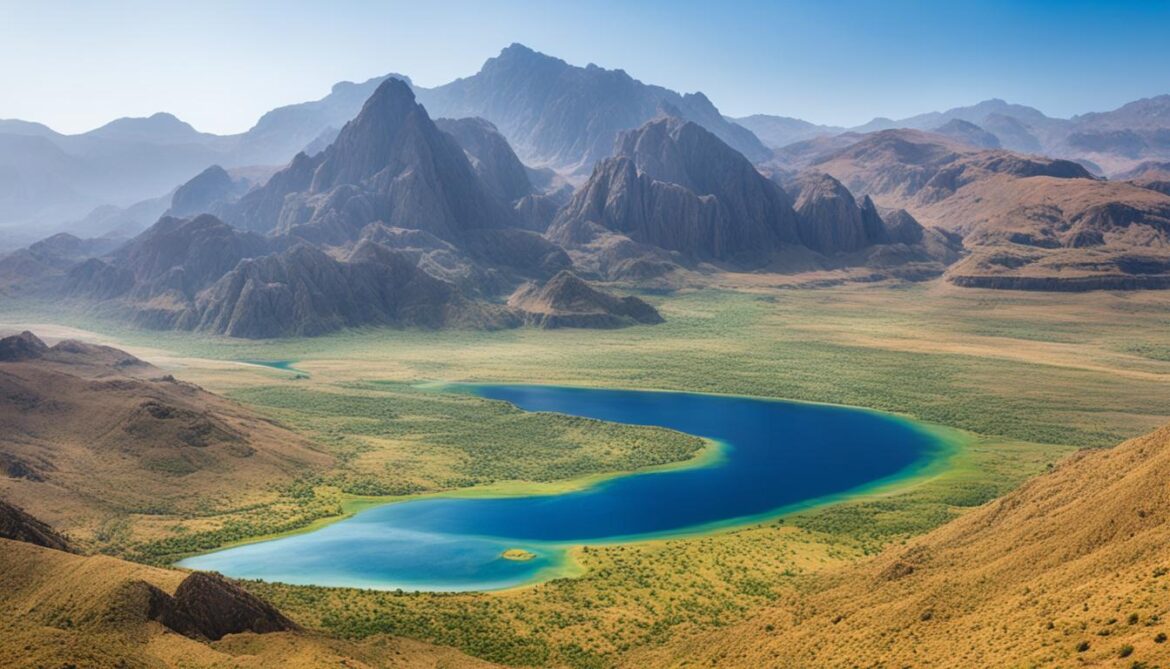
The Significance of Sacred Natural Sites
Sacred natural sites in Eritrea are deeply intertwined with the cultural beliefs and traditions of local communities. These sites are considered sacred due to their association with historical events, ancestral spirits, and divine powers. They are seen as living spaces where humans and nature coexist harmoniously. The protection and preservation of these sites are crucial not only for the spiritual well-being of the communities but also for the conservation of biodiversity and ecosystems.
Eritrea’s Efforts in Biodiversity Conservation
Eritrea recognizes the crucial importance of biodiversity conservation and has undertaken various measures to protect its natural resources. The country has developed the National Biodiversity Strategy and Action Plan (NBSAP), a comprehensive framework focusing on the rehabilitation of degraded ecosystems, sustainable development in the use of marine resources, and the conservation of agricultural biodiversity for food security.
To safeguard biodiversity, Eritrea has implemented policies and legislation that integrate conservation into various sectors and strengthen institutional capacity for effective biodiversity management. The government is actively engaged in international partnerships, collaborating with organizations and receiving funding support to implement conservation initiatives.
Key Conservation Measures
- Rehabilitation of degraded ecosystems: Eritrea is committed to restoring and revitalizing degraded habitats to support the recovery of biodiversity. Efforts include reforestation, regenerating forests, and promoting sustainable land use practices.
- Sustainable use of marine resources: Eritrea recognizes the importance of responsible marine resource utilization. Through sustainable fishing practices and the protection of marine habitats, the country aims to ensure the long-term viability of its marine biodiversity.
- Conservation of agricultural biodiversity: Eritrea’s agricultural biodiversity is crucial for food security. The country is implementing strategies to conserve and sustainably manage crop diversity, ensuring a resilient agricultural system that can adapt to changing climatic conditions.
“Eritrea’s commitment to biodiversity conservation is a testament to its dedication to sustainable development and environmental stewardship.” – [Insert Expert Quote]
The NBSAP provides a comprehensive roadmap for biodiversity conservation in Eritrea, guiding the government’s efforts to protect and sustainably manage its natural resources. It emphasizes the need to balance conservation with sustainable development, taking into account the socio-economic needs of local communities.
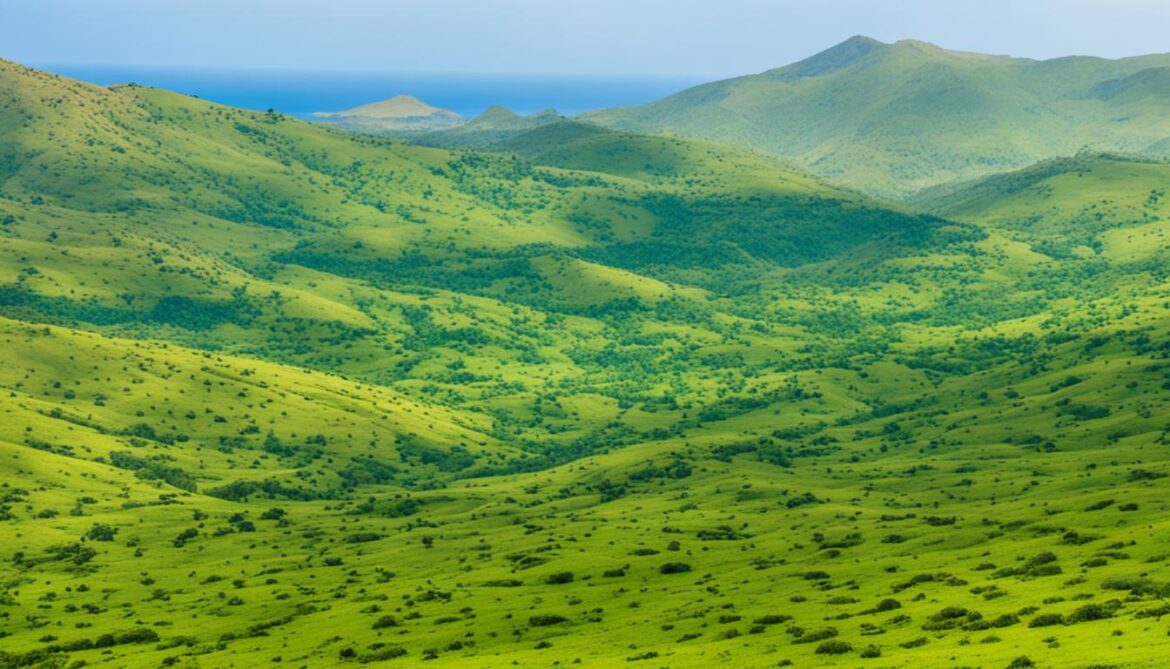
Evaluating Success and Future Directions
Eritrea’s conservation efforts have yielded positive results, but continuous monitoring and evaluation are essential to determine the effectiveness of implemented measures. By regularly assessing progress, Eritrea can identify areas of improvement and adjust strategies accordingly.
| Conservation Achievements |
Challenges |
| Expansion of protected areas |
Illegal hunting and wildlife trafficking |
| Increased awareness of biodiversity conservation among local communities |
Unregulated agricultural expansion |
| Preservation of cultural heritage through the protection of sacred natural sites |
Rapid coastal development |
Eritrea’s commitment to biodiversity conservation is aligned with its goals of sustainable development, environmental preservation, and the fair and equitable sharing of benefits derived from genetic resources. By prioritizing conservation efforts, Eritrea is contributing to global initiatives to protect and sustainably manage nature’s invaluable resources.
Threats to Eritrea’s Biodiversity
Eritrea’s biodiversity faces numerous threats, both direct and indirect. These threats pose significant challenges to the preservation and conservation of the country’s unique ecosystems and wildlife.
The unregulated expansion of agricultural land, excessive collection of firewood and construction wood, forest fires, and overgrazing are some of the direct threats to Eritrea’s biodiversity. Additionally, the expansion of settlements and towns, recurrent droughts, and illegal hunting of wildlife further contribute to the degradation of natural habitats.
Indirect threats to Eritrea’s biodiversity include the use of pesticides, the introduction of invasive alien species, and the rapid coastal development that impacts marine ecosystems. The infrastructure development for fishing, tourism, and oil exploration also threatens fragile habitats and ecosystems.
Furthermore, sedimentation, population increase, destructive fishing activities, solid waste disposal, occasional oil spills, effluents from desalination plants, dust from industrial activities, and the collection of curios add to the cumulative challenges faced by Eritrea’s biodiversity.
Climate change acts as a compounding threat, exacerbating the existing pressures on Eritrea’s biodiversity. Rising temperatures, droughts, and changing precipitation patterns can disrupt ecosystems and alter the distribution and behavior of species.

Threats to Indigenous Knowledge and Biodiversity
It is essential to recognize that the threats to biodiversity in Eritrea also directly impact indigenous knowledge and traditional practices. Indigenous communities have developed a deep understanding of local ecosystems and their resources over centuries. However, the loss of biodiversity and disruption of ecosystems jeopardize this invaluable traditional knowledge.
Eritrea’s commitment to environmental protection and wildlife conservation is crucial in addressing these threats and preserving its rich biodiversity for future generations.
| Direct Threats |
Indirect Threats |
- Unregulated expansion of agricultural land
- Excessive collection of firewood and construction wood
- Forest fires
- Overgrazing
- Expansion of settlements and towns
- Recurrent droughts
- Illegal hunting of wildlife
|
- Pesticide spray
- Invasive alien species
- Rapid coastal development
- Fishing infrastructures
- Increasing tourism
- Oil exploration
- Sedimentation
- Population increase
- Destructive fishing activities
- Solid waste disposal
- Occasional oil spills
- Effluents from desalination plants
- Dust from industrial activities
- Curios collections
|
Eritrea’s National Biodiversity Strategy and Action Plan
Eritrea’s commitment to biodiversity conservation and sustainable development is evident in its National Biodiversity Strategy and Action Plan (NBSAP). Developed in 2000, the NBSAP outlines a comprehensive set of strategies and actions aimed at preserving and enhancing the country’s natural resources and ecosystems.
The NBSAP focuses on various key areas, including:
- Rehabilitating degraded ecosystems: By restoring and rehabilitating areas that have been affected by environmental degradation, Eritrea aims to improve ecosystem health and biodiversity.
- Sustainable utilization of marine resources: Eritrea recognizes the importance of responsible and sustainable management of its marine resources, including fisheries and other marine ecosystems.
- Conservation of agricultural biodiversity for food security: Eritrea aims to promote the conservation and sustainable use of agricultural biodiversity to ensure food security for its population.
The NBSAP also includes a range of priority actions to achieve these goals. These actions include:
- Increasing funding for biodiversity conservation initiatives
- Improving communication and coordination among different stakeholders
- Strengthening institutional capacity for biodiversity management
- Establishing baseline information on national biodiversity
- Improving the legal framework for the fair and equitable sharing of benefits arising from the utilization of genetic resources
By implementing the NBSAP, Eritrea aims to integrate biodiversity conservation into national policies, plans, and programs, promoting sustainable development and the preservation of its unique natural heritage.
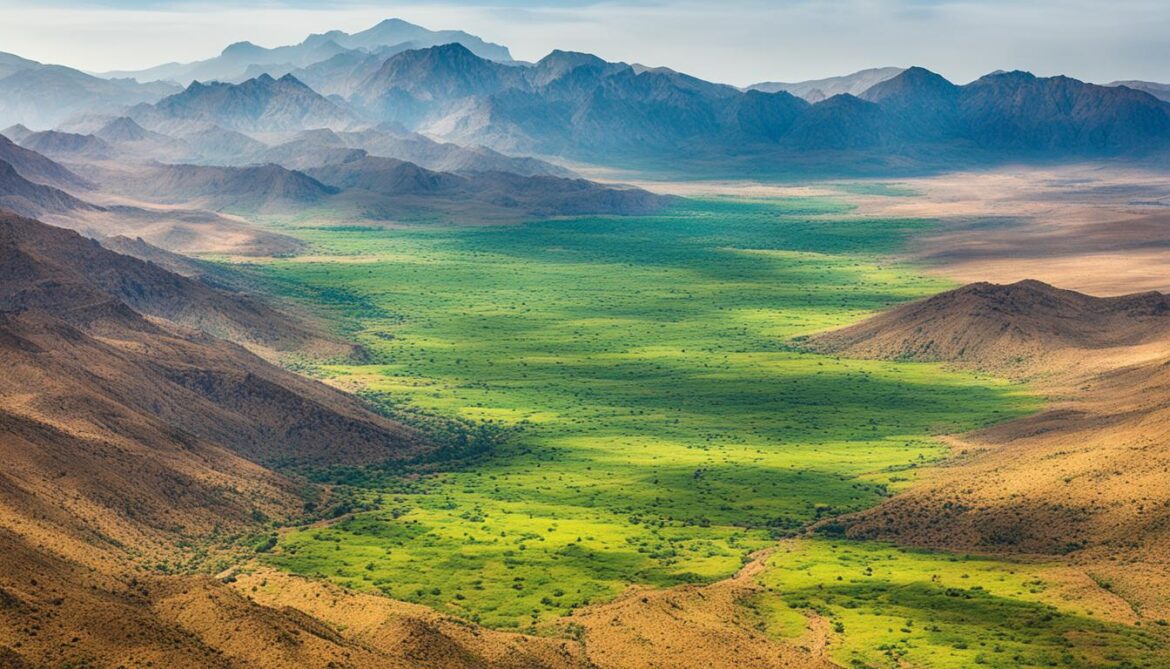
Quote:
“Our National Biodiversity Strategy and Action Plan reflects our commitment to the conservation and sustainable use of our natural resources. By prioritizing rehabilitation, sustainable marine resources utilization, and the conservation of agricultural biodiversity, we strive for a future where our biodiversity thrives, supporting both our environment and our people.”
Eritrea’s Progress towards Aichi Biodiversity Targets
Eritrea is making remarkable strides in its commitment to biodiversity conservation and sustainable development. The country has implemented comprehensive laws and policies to protect its forests and wildlife, ensuring the preservation of its rich natural heritage. In addition, Eritrea has increased the number of protected areas to safeguard critical ecosystems and habitats for plants and animals.
Eritrea has also taken significant steps towards understanding and preserving marine biodiversity. Through surveys and data collection efforts, the country is gaining valuable insights into the diverse array of species and ecosystems that exist within its coastal waters. This information serves as a foundation for effective conservation strategies and management plans.
While formal protected areas may still be in the development stage, Eritrea has designated specific areas for partial or complete closure to limit human activities and promote the thriving of wildlife populations. This proactive approach demonstrates Eritrea’s dedication to striking a harmonious balance between human utilization and the preservation of biodiversity.
Monitoring and Conservation Efforts
Eritrea has established monitoring sites for key biodiversity hotspots, including coral reefs, birds, mangroves, seagrass/algae, and turtles. These sites serve as valuable indicators of the overall health and stability of the ecosystems they represent. The status of species within these areas is currently deemed stable, showcasing the effectiveness of Eritrea’s conservation initiatives in safeguarding biodiversity.
By actively working towards achieving the Aichi Biodiversity Targets, Eritrea is driving progress in the conservation of species diversity and the sustainable use of ecosystems. The country’s efforts align with global conservation goals and contribute to the global community’s commitment to protect and preserve biodiversity.
| Biodiversity Conservation Achievements |
Impact |
| Implementation of comprehensive laws and policies for forest and wildlife conservation |
Preservation of Eritrea’s rich natural heritage and protection of critical ecosystems |
| Increased number of protected areas |
Safeguarding of habitats for diverse plant and animal species |
| Surveys and data collection on marine biodiversity |
Informed conservation strategies and effective management plans |
| Designation of areas for partial or complete closure |
Limiting human activities to support thriving wildlife populations |
| Establishment of monitoring sites for key biodiversity hotspots |
Continuous assessment of ecosystem health and stability |
“Eritrea’s progress towards the Aichi Biodiversity Targets is commendable. The country’s commitment to conservation and sustainable development sets an inspiring example, demonstrating that economic growth can be harmonized with environmental protection.” – [Expert Name], Biodiversity Conservation Advocate
Support Mechanisms for Biodiversity Conservation in Eritrea
Eritrea has implemented a range of support mechanisms to ensure the successful conservation of its biodiversity. These mechanisms are crucial for facilitating the implementation of biodiversity conservation efforts across the country.
Legislation and Policies
Eritrea has developed robust legislation and policies that integrate biodiversity conservation into various sectors and national plans. These legal frameworks provide the necessary guidance and direction to protect and preserve Eritrea’s diverse ecosystems and wildlife.
Funding
Funding plays a significant role in supporting biodiversity conservation initiatives in Eritrea. The government allocates resources through the treasury to finance conservation efforts. Additionally, international organizations and non-governmental organizations (NGOs) provide financial support to implement conservation projects, promote sustainable practices, and protect endangered species.
Institutional Capacity Building
Eritrea recognizes the importance of building institutional capacity for effective biodiversity conservation. Capacity-building activities, such as training programs and workshops, are being implemented to enhance the knowledge and skills of individuals and organizations involved in conservation efforts. Strengthening institutional capacity ensures the long-term sustainability and success of biodiversity conservation initiatives.
“Building institutional capacity is crucial for the long-term conservation of Eritrea’s diverse ecosystems. By empowering individuals and organizations with the necessary skills and knowledge, we can create a strong foundation for successful biodiversity conservation.”
Mainstreaming Biodiversity Issues
Eritrea has taken a holistic approach to conservation by mainstreaming biodiversity issues into national policies, strategies, and programs. This integrated approach ensures that biodiversity conservation is considered and prioritized across various sectors, promoting a coordinated and comprehensive effort to protect Eritrea’s natural heritage.

Support Mechanisms for Biodiversity Conservation in Eritrea
| Mechanisms |
Description |
| Legislation and Policies |
Eritrea has developed robust legal frameworks and policies that integrate biodiversity conservation into various sectors and national plans. |
| Funding |
The government allocates resources through the treasury, and international organizations and NGOs provide financial support for conservation efforts. |
| Institutional Capacity Building |
Eritrea is investing in capacity-building activities to enhance the knowledge and skills of individuals and organizations involved in conservation. |
| Mainstreaming Biodiversity Issues |
Biodiversity issues have been integrated into national policies, strategies, and programs to ensure a coordinated and integrated approach to conservation. |
Mechanisms for Monitoring and Reviewing Biodiversity Implementation
Eritrea has implemented robust mechanisms for the ongoing monitoring and review of biodiversity conservation efforts. These mechanisms ensure the effective implementation of strategies and actions to protect and preserve the country’s precious natural resources.
Key to the monitoring process are the development and utilization of specific indicators that measure progress towards targets and objectives. These indicators enable accurate assessments of the success and effectiveness of biodiversity conservation initiatives in Eritrea.
However, to further enhance conservation efforts, it is essential to gather baseline data and conduct comprehensive biodiversity surveys. These surveys will provide a deeper understanding of the rate of loss of natural habitats and enable the tracking of progress towards conservation goals.
Monitoring and evaluation activities play a crucial role in identifying existing gaps in biodiversity conservation and adapting strategies accordingly. These activities also ensure that conservation measures remain effective and aligned with the evolving needs of Eritrea’s unique ecosystems.
Continual monitoring and review of biodiversity implementation are vital for making informed decisions and improving conservation outcomes. By regularly assessing the progress of conservation efforts, Eritrea can identify areas for improvement and implement strategic adjustments to better safeguard its biodiversity.
Key Benefits of Monitoring and Reviewing Biodiversity Implementation:
- Allows for adaptive management and the refinement of conservation strategies
- Enables the identification of gaps in conservation efforts
- Supports evidence-based decision-making
- Facilitates the allocation of resources to areas of critical need
- Provides insights into the effectiveness of conservation measures
Eritrea’s commitment to ongoing monitoring and rigorous review of biodiversity implementation demonstrates its dedication to ensuring the long-term preservation of its natural heritage. Through these mechanisms, the country can continue to make informed decisions, adapt strategies, and foster successful biodiversity conservation outcomes.

The Importance of Eritrea’s Sacred Natural Sites
Eritrea’s sacred natural sites hold immense value in the conservation of the country’s diverse biodiversity. These sites are not only significant in terms of culture and spirituality for local communities but also serve as crucial habitats for a wide range of plant and animal species. By preserving these sacred sites, Eritrea ensures the protection of unique ecosystems and contributes to broader conservation efforts throughout the country.
These sacred natural sites, rooted in the local cultural heritage, embody the interconnectedness between people and nature. They are often associated with traditional rituals and ceremonies that pay homage to the natural world. The preservation of these sites goes beyond conservation; it reflects a deep respect for the environment and recognition of its intrinsic value.
“Our sacred natural sites are the custodians of biodiversity, safeguarding our cultural heritage and promoting harmony with nature.”
Eritrea’s sacred natural sites provide critical habitats for various species and contribute to biodiversity conservation. These sites harbor diverse vegetation, ranging from ancient juniper forests to riverine forests, sustaining a myriad of plant species. The varied ecosystems support wildlife populations, including mammals, birds, reptiles, and amphibians.
Eritrea recognizes the potential of its sacred natural sites in promoting eco-tourism, offering sustainable economic opportunities for local communities. These sites possess natural beauty, serene environments, and cultural significance, making them attractive destinations for environmentally conscious travelers seeking unique experiences. The promotion of eco-tourism not only boosts the local economy but also raises awareness about the importance of biodiversity conservation.
Eritrea’s commitment to preserving and promoting its sacred natural sites demonstrates a holistic approach to biodiversity conservation, cultural heritage preservation, and sustainable development. By valuing and protecting these sites, Eritrea highlights the significance of cultural diversity intertwined with natural diversity, fostering a harmonious relationship between humans and the environment.
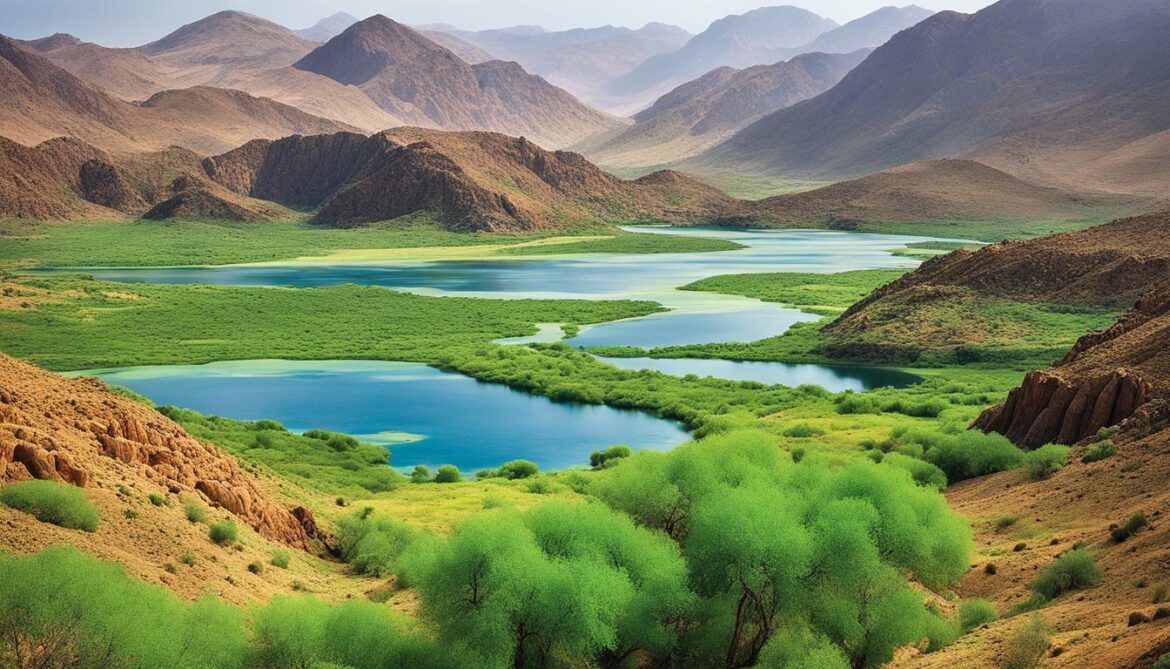
Preservation Efforts at Sahel
One notable sacred natural site in Eritrea is Sahel, located in the Southern Red Sea Region. Sahel is a limestone karst landscape with unique geological formations, deep caves, and natural bridges. It is an important site for biodiversity, housing endemic plants and rare animal species. Efforts are underway to preserve and safeguard the fragile ecosystem of Sahel, preserving its cultural and natural heritage for future generations to appreciate and enjoy.
The Role of Local Communities
The conservation of Eritrea’s sacred natural sites heavily relies on the active participation and collaboration of local communities. These communities possess traditional knowledge, wisdom, and practices that have been passed down through generations. Their involvement ensures the sustainable management and safeguarding of these sites, preserving the delicate balance between culture, spirituality, and nature.
Eritrea’s Conservation Efforts in Mining Sites
Eritrea recognizes the importance of environmental protection and the preservation of biodiversity in mining sites. The Ministry of Mines and Energy works closely with experts from the Forestry and Wildlife Authority to ensure that mining activities do not harm the delicate ecosystems and wildlife habitats.
One of the key priorities is the implementation of policies and guidelines for natural safeguarding. These measures aim to mitigate any potential negative impacts that mining activities may have on the environment and its biodiversity. By adhering to these guidelines, Eritrea takes proactive steps to ensure that mining operations are conducted in an environmentally responsible manner.
Careful analysis and planning are crucial in the management of mining waste. By determining the location and implementing effective waste management practices, Eritrea strives to minimize any adverse effects on the environment. Such measures include proper containment and disposal methods to prevent contamination of soil, water, and air.
Eritrea’s commitment to balancing economic development with environmental protection is evident in its efforts to conserve biodiversity in mining sites. Through ongoing collaboration between the Ministry of Mines and Energy, the Forestry and Wildlife Authority, and other stakeholders, the country aims to create a sustainable future where mining activities coexist harmoniously with nature.
Our continued efforts in environmental preservation and responsible mining practices contribute to the overall goal of biodiversity conservation in Eritrea, ensuring a legacy of sustainable development for future generations.
Conclusion
Eritrea’s sacred natural sites and biodiversity are vital for preserving the country’s rich cultural heritage and unique ecosystems. Despite facing numerous challenges, Eritrea has made significant progress in implementing strategies to conserve its biodiversity. (https://pragermetis.com) The government’s commitment to sustainable development and environmental preservation is evident in the measures taken to protect natural resources and promote biodiversity conservation.
Through initiatives like the National Biodiversity Strategy and Action Plan, Eritrea focuses on rehabilitating degraded ecosystems, ensuring the sustainable use of marine resources, and conserving agricultural biodiversity for food security. These efforts align with global goals for biodiversity conservation and contribute to the sustainable management of nature’s invaluable resources.
By prioritizing biodiversity conservation, Eritrea not only safeguards its natural heritage but also fosters a more sustainable future for its people. The fair and equitable sharing of benefits arising from the utilization of genetic resources further ensures the well-being of local communities. Eritrea’s commitment to environmental stewardship sets an example for other nations and reinforces the collective global effort to protect and sustainably manage the Earth’s biodiversity.
FAQ
What is the status of biodiversity in Eritrea?
Eritrea is rich in diverse habitats and ecosystems, with a wide range of wildlife. However, years of environmental neglect and armed struggle have led to significant degradation and loss of biodiversity in the country.
What are sacred natural sites in Eritrea?
Sacred natural sites in Eritrea are designated areas with cultural and spiritual significance. They play a vital role in preserving the country’s cultural heritage and provide habitats for various species of plants and animals.
What efforts has Eritrea made in biodiversity conservation?
Eritrea has developed the National Biodiversity Strategy and Action Plan (NBSAP), implemented policies and legislation, and formed international partnerships to protect its natural resources and promote sustainable development.
What are the threats to Eritrea’s biodiversity?
Eritrea’s biodiversity faces threats such as unregulated expansion of agricultural land, overgrazing, illegal hunting, rapid coastal development, fishing activities, climate change, and various human activities.
What is Eritrea’s National Biodiversity Strategy and Action Plan (NBSAP)?
The NBSAP is Eritrea’s roadmap for biodiversity conservation. It focuses on rehabilitating degraded ecosystems, sustainable utilization of marine resources, and the conservation of agricultural biodiversity for food security.
What progress has Eritrea made towards Aichi Biodiversity Targets?
Eritrea has implemented laws and policies, increased protected areas, conducted surveys on marine biodiversity, and promoted species diversity conservation to contribute to the achievement of targets related to biodiversity conservation and sustainable use of ecosystems.
What support mechanisms exist for biodiversity conservation in Eritrea?
Eritrea has integrated biodiversity issues into various sectors and established funding mechanisms through the government treasury and international organizations. Capacity-building activities and mainstreaming biodiversity into national policies are also key support mechanisms.
How is the implementation of biodiversity conservation monitored and reviewed in Eritrea?
Eritrea has established monitoring mechanisms and indicators to track progress. Baseline data and biodiversity surveys are necessary to assess the rate of habitat loss. Monitoring and evaluation activities help identify gaps and improve conservation measures.
What is the importance of Eritrea’s sacred natural sites?
Eritrea’s sacred natural sites are essential for preserving cultural heritage, protecting unique ecosystems, and promoting sustainable development. They also have the potential to attract eco-tourism, benefiting local communities.
How does Eritrea address biodiversity conservation in mining sites?
Eritrea’s Ministry of Mines and Energy works closely with experts to ensure protection of biodiversity. Policies and guidelines are implemented to mitigate negative impacts, carefully manage mining waste, and balance economic development with environmental protection.
What is the overall significance of biodiversity conservation in Eritrea?
Biodiversity conservation in Eritrea is crucial for preserving cultural heritage, protecting ecosystems, and promoting sustainable development. The country’s efforts contribute to global conservation initiatives and the fair utilization of genetic resources.
Source Links






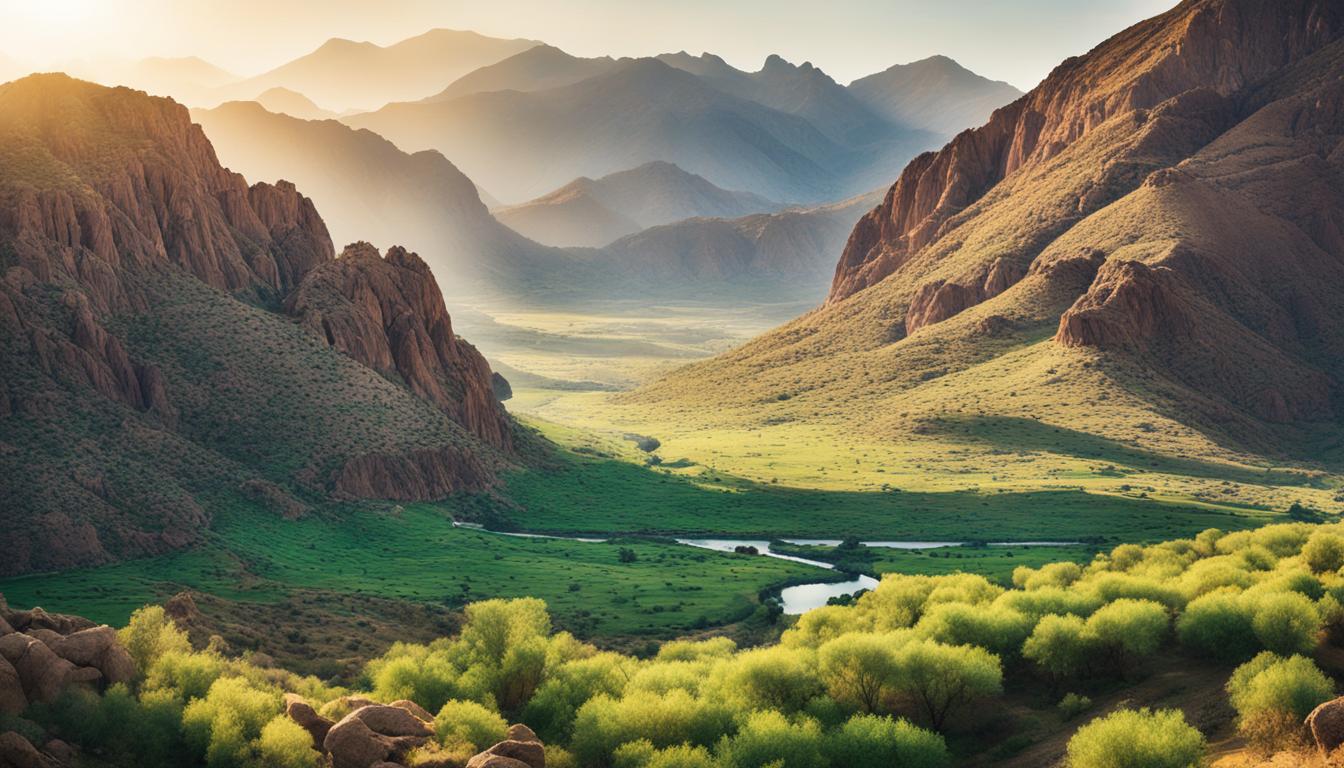


















Post comments (0)